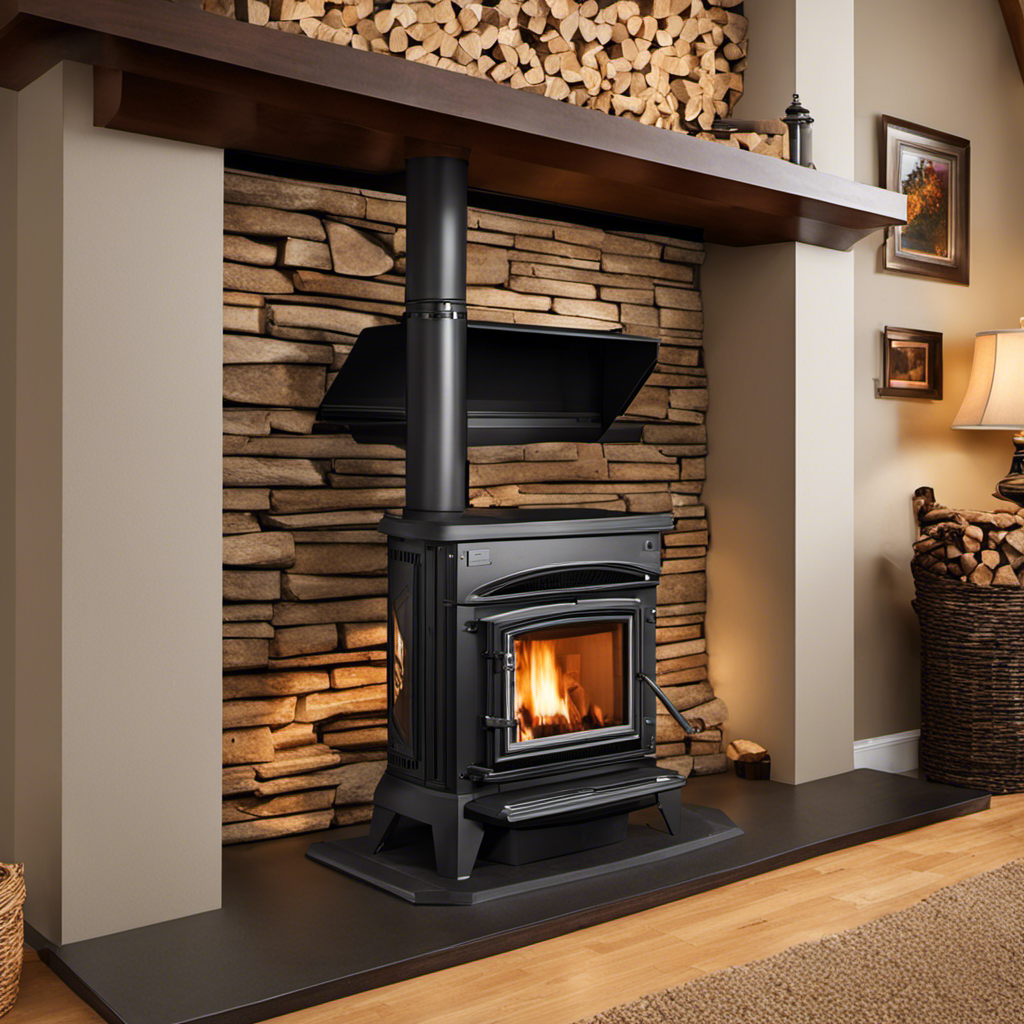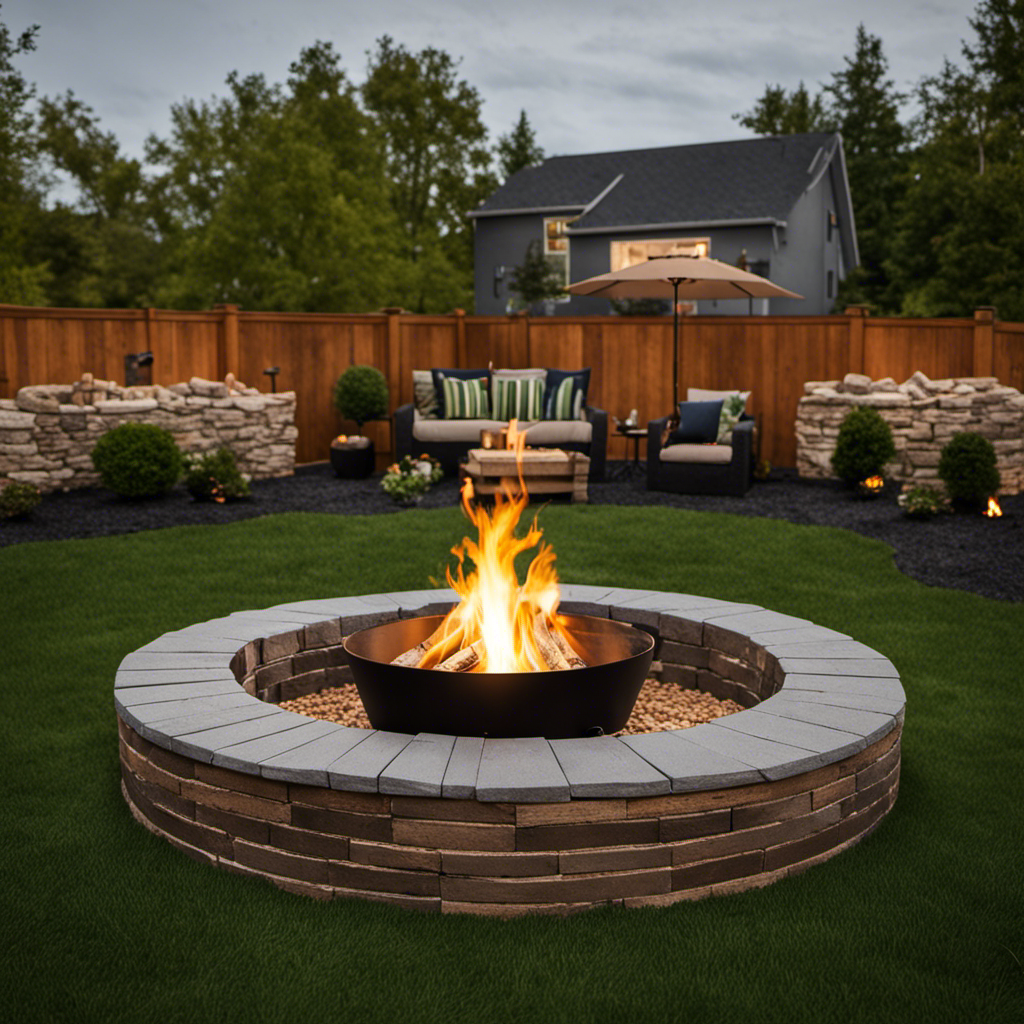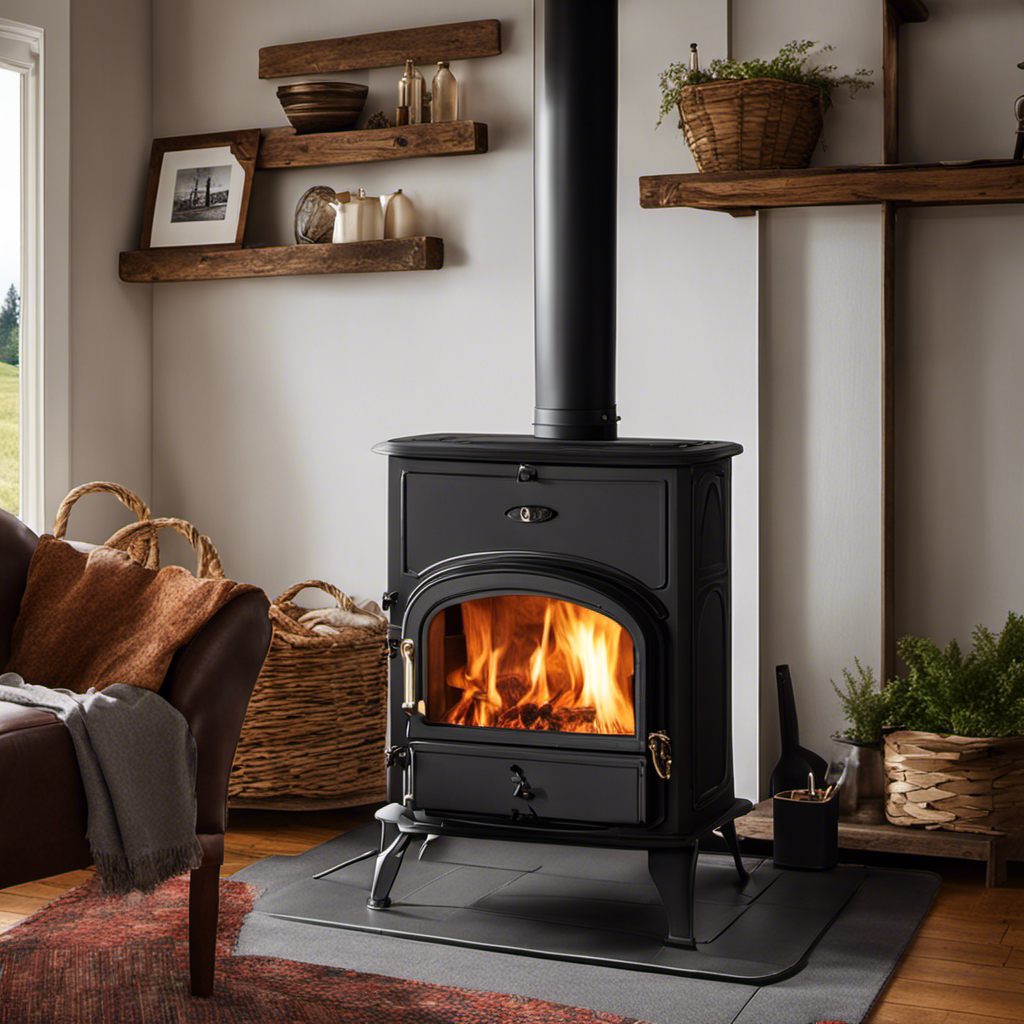As an experienced DIY enthusiast, I’ve always held the belief that home improvement projects are like puzzles waiting to be solved.
And if you’re looking to add both warmth and charm to your living space, installing a wood pellet stove insert may just be the missing piece.
In this comprehensive guide, I’ll walk you through each step of the installation process, from choosing the perfect location to maintaining and cleaning your new pellet stove insert.
So let’s dive in and turn your fireplace into a cozy haven!
Key Takeaways
- Choose the right location based on proximity to vent, clearance requirements, and room size
- Properly prepare the existing fireplace by cleaning and inspecting the chimney
- Measure and cut the opening accurately using appropriate tools and safety precautions
- Install the venting system correctly, considering the type of vent pipe and avoiding obstructions
Choosing the Right Location
You’ll need to consider factors such as proximity to a vent, clearance requirements, and the size of the room when choosing where to install your wood pellet stove insert.
Ventilation requirements are crucial for the safe operation of your stove. Make sure there is proper airflow in the room and that the venting system meets all safety standards.
It’s also important to check if there are any specific clearance requirements specified by the manufacturer. This ensures that there is enough space around the stove for proper heat dissipation and reduces fire hazards.
Additionally, consider the size of the room. A larger room may require a more powerful insert while a smaller one may work well with a smaller unit.
Now that we’ve discussed locating an appropriate spot for your wood pellet stove insert, let’s move on to preparing the existing fireplace…
Preparing the Existing Fireplace
To properly prepare the existing fireplace, first ensure that it is clean and free of any debris. This step is crucial for a successful installation of a wood pellet stove insert. Start by removing any ashes or soot from the firebox using a small shovel and brush. Take care to dispose of these materials properly, as they can be flammable.
Next, use a vacuum cleaner with a brush attachment to thoroughly clean the inside of the fireplace, including the walls and floor. Pay close attention to any crevices or corners where debris may accumulate. Additionally, inspect the chimney for any blockages or obstructions that could hinder proper ventilation.
Once the fireplace is clear and clean, you can move on to measuring and cutting the opening for your new wood pellet stove insert.
Transition: Now that the existing fireplace is prepared and ready, it’s time to move on to measuring and cutting the opening for our wood pellet stove insert…
Measuring and Cutting the Opening
Now that the fireplace is clean, it’s time to begin measuring and cutting the opening for your new stove insert. This step is crucial to ensure a proper fit and maximize heating efficiency. To achieve measuring accuracy, you will need a tape measure and a straight edge. Measure the width, height, and depth of the fireplace opening at multiple points to account for any irregularities.
Once you have accurate measurements, it’s time to gather the cutting tools needed. You will require an angle grinder with a masonry blade or a reciprocating saw with a metal-cutting blade to cut through brick or stone. Additionally, have safety goggles and gloves on hand for protection during this process.
Transitioning into installing the venting system, we can now move forward with creating an appropriate pathway for smoke and gases to safely exit your home without compromising air quality.
Installing the Venting System
Once the venting system is in place, make sure to secure all connections and inspect for any potential leaks. Proper installation of the venting system is crucial for the safe and efficient operation of your wood pellet stove insert.
Here are some venting system installation tips to help you along the way:
-
Choose the right type of vent pipe: There are two main types – single-wall and double-wall pipes. Double-wall pipes provide better insulation and reduce heat loss.
-
Plan your route: Determine the best path for the vent pipe, avoiding obstructions and maintaining proper clearances as per manufacturer’s guidelines.
-
Use appropriate supports: Install support brackets at regular intervals to ensure stability and prevent sagging or separation.
-
Seal all connections: Use high-temperature silicone or metal tape to seal joints between sections of pipe, elbows, and termination points.
-
Troubleshoot common venting issues: Look out for blockages, such as bird nests or debris, which can restrict airflow and cause poor performance.
By following these tips, you can ensure a successful installation of your venting system.
Now let’s move on to connecting the pellet stove insert without any further delay.
Connecting the Pellet Stove Insert
Make sure you have all the necessary tools and materials ready before starting the process of connecting your new pellet stove insert.
Here are a few key steps to help you successfully connect your pellet stove:
-
Turn off the power: Before working with any electrical connections, make sure to turn off the power to avoid any accidents or damage.
-
Connect the wires: Carefully follow the manufacturer’s instructions to connect the electrical wires from your pellet stove insert to the corresponding outlets in your home. Double-check that all connections are secure.
-
Test for functionality: Once everything is connected, turn on the power and test if your pellet stove is functioning properly. If not, troubleshoot common issues such as loose connections or blown fuses.
-
Inspect for safety: After connecting the electrical wires, inspect all other components of your pellet stove insert for any potential safety hazards.
With the electrical wiring complete, it’s time to move on to securing the insert in place without delay.
Securing the Insert in Place
When it comes to securing a pellet stove insert in place, there are two key considerations: anchoring methods for stability and ensuring a proper fit.
Anchoring methods can include using brackets, screws, or even adhesive to securely attach the insert to the existing fireplace. This ensures that the insert remains stable and doesn’t shift or move during operation.
Additionally, ensuring a proper fit is crucial for efficient heating and preventing any drafts or leaks. This involves measuring the dimensions of both the insert and the fireplace opening accurately and making any necessary adjustments to achieve a snug and secure fit.
Anchoring Methods for Stability
To ensure stability, you’ll want to use one of these anchoring methods for your wood pellet stove insert:
-
Floor Mounting: This method involves securing the insert directly to the floor using bolts or brackets. It provides a sturdy foundation and is ideal for concrete or tile floors.
-
Wall Bracing: By attaching support brackets to the wall behind the insert, you can prevent any movement or tipping. This method is suitable for both drywall and masonry walls.
-
Hearth Extension: Adding a hearth extension not only enhances safety but also helps stabilize the insert. Choose from various materials like stone, brick, or tile to match your decor.
-
Corner Support: If your wood pellet stove insert is installed in a corner, consider adding corner supports to reinforce its stability and prevent any wobbling.
-
Anchoring Straps: These heavy-duty straps can be used to secure the insert to nearby walls or surrounding structures.
By following these anchoring methods, you can ensure that your wood pellet stove insert remains securely in place.
Now let’s move on to ensuring proper fit without compromising ventilation requirements.
Ensuring Proper Fit
Ensure that your measurements are accurate and take into account any clearance requirements for a proper fit. Proper measurements are crucial to ensure that the wood pellet stove insert fits securely and functions efficiently. Before starting the installation process, I highly recommend consulting with a professional installer to guarantee a safe and effective installation.
Professional installation not only ensures that all necessary steps are followed correctly but also guarantees compliance with local building codes and regulations. They have the experience and expertise to assess any potential challenges or obstacles that may arise during the installation process.
Once the wood pellet stove insert is properly installed, it’s time to test for proper operation. This step involves checking if all components are functioning correctly, such as the ignition system, fan, thermostat, and exhaust system. By testing for proper operation, you can identify any issues early on and address them promptly before regular use of your wood pellet stove insert.
Transition: Now that we have ensured a proper fit and tested for proper operation…
Testing for Proper Operation
Before starting the wood pellet stove insert, make sure it’s functioning properly. Testing for proper operation is crucial to ensure efficient heating and avoid potential issues down the line.
To test the efficiency, start by inspecting the fuel hopper and checking for any blockages or debris. Next, light the stove according to the manufacturer’s instructions and observe the flame pattern and color. A steady blue flame indicates optimal combustion. If you notice a yellow or orange flame, it may indicate a problem with air intake or insufficient ventilation.
Troubleshooting common issues such as irregular flame patterns or excessive smoke emission can help identify any underlying problems that need to be addressed before installation continues.
Now that we have tested for proper operation, let’s move on to sealing and insulating the surrounding area without writing ‘step’.
Sealing and Insulating the Surrounding Area
After testing the wood pellet stove insert for proper operation, it’s time to move on to sealing and insulating the surrounding area.
This step is crucial in ensuring that your wood pellet stove insert operates efficiently and safely. There are various sealing methods you can use, such as caulking or using high-temperature sealants, to prevent any air leaks around the stove insert. These seals will help maintain a consistent temperature and prevent any drafts from entering your home.
Additionally, it’s important to insulate the walls and floor surrounding the stove insert with appropriate insulation materials like rock wool or ceramic fiber boards. This insulation will further enhance energy efficiency by reducing heat loss.
Now that we have sealed and insulated the area properly, let’s move on to adding finishing touches without delay.
Adding Finishing Touches
When it comes to adding finishing touches to a wood pellet stove insert installation, there are several key points to consider.
First, you’ll want to explore the various trim and molding options available, as these can greatly enhance the overall aesthetic of the installation.
Once you’ve decided on the appropriate trim and molding, it’s important to carefully execute their installation in order to achieve a polished look that seamlessly blends with your existing decor.
Trim and Molding Options
There’s a variety of trim and molding options to choose from for your wood pellet stove insert. When it comes to enhancing the aesthetic of your stove, the right trim and molding can make a big difference.
Here are four options to consider:
-
Crown Molding: This classic choice adds elegance and sophistication to your stove insert, creating a seamless transition between the stove and the surrounding wall.
-
Fluted Pilasters: These decorative columns bring a touch of traditional charm to your stove insert, giving it a more refined look.
-
Rope Trim: If you prefer a more intricate design, rope trim is an excellent choice. It adds texture and detail to the edges of your stove insert, making it visually appealing.
-
Beveled Trim: For a sleek and modern appearance, beveled trim is an ideal option. Its clean lines create a contemporary look that complements any decor style.
Enhancing the Aesthetic
To enhance the aesthetic of your wood pellet stove insert, consider choosing the right trim and molding styles that suit your personal taste and complement the decor of your room.
There are many decorating ideas you can explore to make your stove insert a beautiful focal point in your space. When it comes to trim options, you can opt for simple and sleek designs for a modern look or go for more intricate and ornate styles for a traditional feel. Additionally, color options are also important in creating the desired ambiance. You could choose a trim color that matches or contrasts with the surrounding walls to create visual interest.
By carefully selecting the right trim and molding styles as well as considering various color options, you can truly enhance the overall aesthetic of your wood pellet stove insert installation.
Now that you have selected the perfect trim and molding for your wood pellet stove insert, it’s time to move onto finalizing the installation process.
Finalizing the Installation
Now that you’ve chosen the perfect trim and molding for your wood pellet stove insert, it’s time to complete the final steps of the installation process.
Securing the stove insert and ensuring proper ventilation are crucial aspects of this stage. To secure the insert in place, use screws or brackets provided by the manufacturer. Make sure to follow their instructions carefully to ensure a safe and secure installation.
Proper ventilation is essential for efficient operation and safety. Ensure that there is sufficient clearance around the stove insert as specified by local building codes. Additionally, make sure that any venting components are properly connected and sealed to prevent any leaks or drafts.
With these final installation steps completed, we can now move on to maintaining and cleaning your pellet stove insert.
Transitioning into maintaining and cleaning the pellet stove insert, let’s explore how you can keep your appliance in top condition for years to come.
Maintaining and Cleaning the Pellet Stove Insert
Regularly cleaning the ash and soot buildup is essential for maintaining a wood pellet stove insert. To keep my stove running efficiently, I use a few simple cleaning techniques.
First, I make sure to empty the ash pan regularly to prevent it from overflowing. Then, I remove the burn pot and clean it thoroughly with warm soapy water to remove any residue.
Next, I vacuum out the firebox and flue pipe to eliminate any accumulated debris. Troubleshooting common issues is also important in keeping my pellet stove in top shape.
If I notice poor flame quality or reduced heat output, I check the air intake and exhaust vents for blockages. Additionally, if there are ignition problems, I inspect the igniter for damage or wear and replace it if necessary.
Frequently Asked Questions
How Much Does a Wood Pellet Stove Insert Typically Cost?
The cost range for a wood pellet stove insert can vary depending on several factors. These factors include the brand, size, features, and installation requirements. It is important to consider these factors when determining the overall cost of a wood pellet stove insert.
What Kind of Regular Maintenance Does a Wood Pellet Stove Insert Require?
Regular maintenance for a wood pellet stove insert includes cleaning the burn pot, checking the exhaust system, and inspecting the hopper and auger system. It’s important to keep these components clean and in good working condition for optimal performance.
Can a Wood Pellet Stove Insert Be Installed in a Mobile Home?
Installing a wood pellet stove insert in a mobile home can be a great option. Not only does it provide efficient heating, but it also complies with mobile home regulations, making it a safe and practical choice.
Are There Any Safety Precautions That Need to Be Taken When Using a Wood Pellet Stove Insert?
When using a wood pellet stove insert, it is important to take safety precautions. These include regularly cleaning the stove and chimney, keeping flammable objects away, and installing carbon monoxide detectors for added protection.
How Long Does It Take to Install a Wood Pellet Stove Insert?
Installing a wood pellet stove insert typically takes around 4-8 hours, depending on the complexity of the installation process. It involves securing the insert in place, connecting it to the chimney or venting system, and ensuring proper insulation and safety measures are in place.
Conclusion
In conclusion, installing a wood pellet stove insert can be a rewarding and enjoyable experience. By following the steps outlined in this article, you can transform your existing fireplace into a cozy and efficient heating source.
Just like adding the final touches to a masterpiece painting, sealing and insulating the surrounding area will ensure that your new insert operates at its best.
With regular maintenance and cleaning, your pellet stove insert will continue to provide warmth and comfort for years to come.
So go ahead, let the flames dance and embrace the allure of a perfectly installed wood pellet stove insert.











